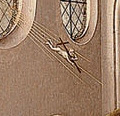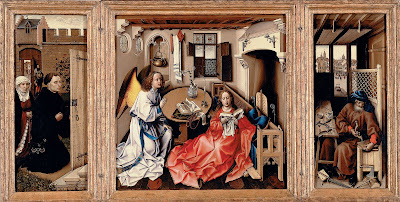Campin's Merode Altarpiece is not
only an example of a fine oil painting but is also a definitive painting of the
Northern European Renaissance. It is a
triptych, which is a painting on three hinged panels that can be folded
together. The three panels of Campin's
altarpiece show three images: the donors of the work kneeling in a garden, the
Annunciation, and Joseph working in his carpentry shop.
First off on the left panel we see
the patrons who commissioned Campin to paint this. They are kneeling humbly and the woman is
holding prayer beads, so it's safe to say these patrons wanted to be remembered
for their religious devotion. The man
has even removed his hat.
On the right panel is Joseph the
carpenter seen with woodworking tools of the time. Campin took time to paint the realistic wood
shavings, nails, and lines—stunning attention to detail. The tools at the bottom of the picture serve
as hidden symbolism, something Campin mastered.
The saw, axe, and rod all refer to Isaiah 10:15.
The center panel, the Annunciation,
contains lots of symbolism, so take another look.

This is the moment when the angel Gabriel comes to Mary to announce
her pregnancy with the Messiah. The
angel is of course wearing white, signaling his purity, and Mary is wearing a
red dress once again, symbolic of Christ's blood to be shed. By the way, Campin's precision with detail
here again shown: look at all the creases and folds of her dress. It also makes her appear a lot larger than
she really is. She is sitting calmly,
reading her Bible. The white linen
towels hanging on the wall behind her further proclaim her purity—white linen
is symbolic of purity. The empty pot
next to those denotes that Mary is "a clean vessel to be
filled." (I'm not making this
up.) On the table we see an open book,
the pages of which are turning (perhaps the angel entered with a gust of wind
that caused the pages to turn—at any rate it doesn't faze Mary from her
devotion to the Word). There is a candle
on the table—remember that candles and light are a symbol of God's presence. But this candle is extinguished—there is a
lit one above the fireplace, though—foreshadowing Christ's death. There are three flowers in the vase,
representing the Trinity, one of which has not bloomed yet (the Messiah, who
actually makes an appearance in this painting).
Lastly, the embryo (I guess?) of our Lord, carrying His own miniature
cross, comes down from Heaven, enters through the window, and is seen heading
straight for Mary's belly.




No comments:
Post a Comment